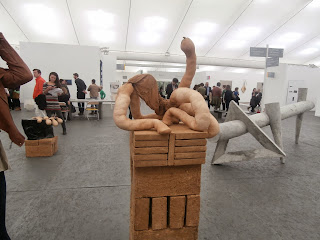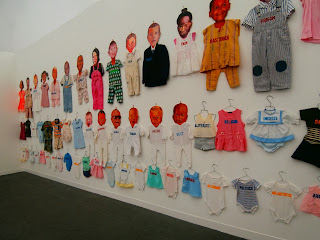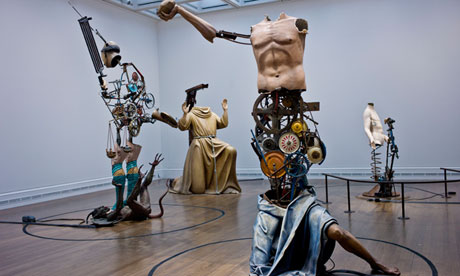You can read this article in the December 13 issue of Pi
Gilbert and George are probably two of the most interesting 70
year olds you will probably meet. Seven years ago they held the biggest ever
retrospective at the Tate Modern, and they are still creating work even now.
Having studied at St Martins university in London many year ago, where they
first met, they embarked on one of the most unusual artists careers of the
time, claiming themselves to be ‘Living Sculptures’, as, even to his day, they
refuse to disassociate themselves from their art.
The White Cube gallery is currently holding talks with significant
players in the art world, as a way of opening young people to the different
areas of the art world, and I recently got to go to see Tim Marlow in
conversation with Gilbert and George. It was eye-opening, interesting and even
a little controversial, and I’ve officially decided Gilbert and George are my
favourite over 70’s gentlemen.
The most interesting thing about an artist is their quirks, right?
Gilbert and George have a lot. They are constantly dressed in matching suits,
which they justified by saying “you can always get a table in a restaurant and
never get searched at airports”, and they famously don’t have a kitchen,
because they don’t want to clutter their minds with unnecessary things. They
literally want to focus all their attention onto their art, and for that reason
they have dinner at the same restaurant every night. And they have the same
thing, because looking at a menu is classed as clutter too.
As the talk initially focused on start ups and beginnings, Gilbert
and George explain how mainly their beginnings stemmed from luck and intense
advertising of their first show – they used badges, megaphones, sweets,
everything they could, to get people to come and visit their first ‘Living
Sculptures’ show at the Nigel Greenwood Gallery in 1970, and it worked. From
the word go, they decided that they’re motto would be ‘Art for All’, and this
becomes exceedingly obvious when we bring their views into consideration.
After letting us know that Darwin
“When we were young, money, sex and religion weren’t polite
topics. Even in countries like Russia Africa , Arab countries, it is still not polite.”
Gilbert went on to talk about a pieces of art they recently made called ‘Islam’
and ‘Mosque’, which included slanderous words against Islam, which addressed
Arab culture in a western light, and has controversially been on show in Doha
recently. These artists problem with art now is that whilst it seems
‘appropriate’ to criticise Christian religion or Judaism or sex, artists steer
clear of Islam due to the extreme nature of the religion itself. Understandable,
seeing as Gilbert and George are two gay men who live in the East End and have Muslim extremists next door, yet
they are brave enough to break through that barrier into the dangerous. “Ban
religions”, was their final note on religion.
Other major changes that they have noticed in the art world are
both the size and the fame - “In the late 60’s and early 70’s, the art world
was the tiniest thing in the world. Paris , New York London
Having lived and worked together for so long, Marlow asks them if
they ever argue. “The whole world is a battle – stabbings, murders, wars. It’s
a painful screaming world” is their justification for not arguing, and it makes
sense. All they do is address these issues in their art which must be quite
humbling for them – there are such large issues in the world that their simple
lives seem quite trivial.
The part of the talk that sums up Gilbert and George to a tee has
to be the end. Marlow asks “did you devise any rules for being an artist?” The
answer seemed to be YES when they started reeling off rules such as ‘always be
smartly dressed and polite’, ‘make the world believe in you’, ‘never worry or
criticise, stay calm’, ‘make use of sex’, ‘reinvent life’, ‘give something
back’, and their final piece of art for all aspiring artists? “Fuck the
teachers”.








































